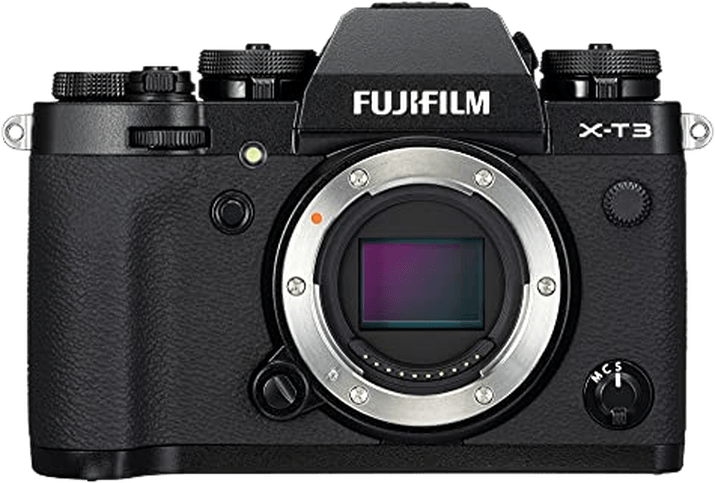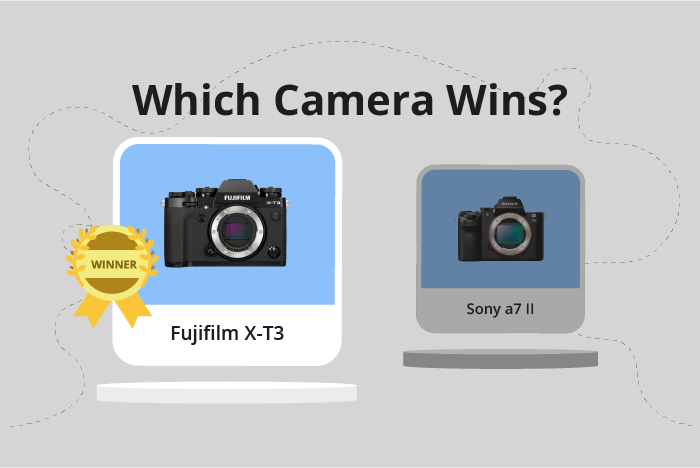Fujifilm X-T3 vs Sony a7 II Comparison
Fujifilm X-T3

Sony a7 II

The Fujifilm X-T3 outperforms the Sony a7 II with a score of 72/100 compared to 69/100. Both cameras are mirrorless and were released in 2018 and 2014, respectively. They share similarities in size, with the X-T3 measuring 133 x 93 x 59mm and the a7 II at 127 x 96 x 60mm.
The X-T3 excels with its lighter weight of 539g, compared to the a7 II’s 599g, making it more comfortable for extended use. Additionally, the X-T3’s launch price of $539 is significantly lower than the a7 II’s $1600, making it a more affordable option.
On the other hand, the Sony a7 II may offer advantages in specific features not mentioned in the general specifications. However, based on the information provided, the Fujifilm X-T3 is the superior choice due to its higher score, lighter weight, and more budget-friendly price.
Fujifilm X-T3 vs Sony a7 II Overview and Optics
The Sony a7 II takes the lead in our optics comparison with a score of 78/100, while the Fujifilm X-T3 trails with a score of 67/100. Both cameras share common specifications, including a CMOS sensor, and compatibility with their respective lens mounts – Fujifilm X for the X-T3 and Sony E for the a7 II.
The Sony a7 II excels due to its full-frame sensor, which provides better image quality and low-light performance compared to the Fujifilm X-T3’s APS-C sensor. Moreover, the a7 II boasts a DXOMARK score of 90, validating the superiority of its sensor, while the X-T3 lacks a DXOMARK score. Another advantage of the Sony a7 II is its built-in image stabilization, which helps in reducing camera shake and producing sharper images.
On the other hand, the Fujifilm X-T3 has a higher megapixel count of 26, compared to the Sony a7 II’s 24.2 megapixels, allowing for slightly more detailed images. Additionally, the X-T3 outperforms the a7 II in shooting speed, with an impressive 20 frames per second compared to the a7 II’s 5 frames per second. This makes the Fujifilm X-T3 more suitable for capturing fast-moving subjects.
While the Fujifilm X-T3 has its advantages in megapixels and shooting speed, the Sony a7 II’s full-frame sensor and image stabilization make it a better choice for photographers prioritizing image quality and low-light performance. Consequently, the Sony a7 II’s higher score reflects its superior optical performance in these crucial aspects.
Fujifilm X-T3 vs Sony a7 II Video Performance
The Fujifilm X-T3 outperforms the Sony a7 II in video capabilities with a score of 83/100, a 27-point difference compared to the Sony’s 56/100 score. Both cameras share some common specifications, including a maximum video frame rate of 60fps.
The Fujifilm X-T3 excels with its 4K video resolution and dimensions of 4096 x 2160, offering superior image quality and detail compared to the Sony a7 II, which has a Full HD video resolution and dimensions of 1920 x 1080. Additionally, the X-T3 has built-in time-lapse functionality, providing more creative options for filmmakers and photographers.
The Sony a7 II, while lacking in video resolution and time-lapse functionality, still performs well with its 60fps frame rate, allowing for smooth motion capture in Full HD. This may be sufficient for users who do not require the higher resolution offered by the Fujifilm X-T3.
Considering these factors, the Fujifilm X-T3 is the clear winner in terms of video capabilities, with its higher resolution and added time-lapse feature. The Sony a7 II, on the other hand, is a viable option for those who prioritize other aspects of a camera and do not require 4K video resolution.
Fujifilm X-T3 vs Sony a7 II Features and Benefits
The Fujifilm X-T3 emerges as the superior camera with a feature score of 83/100, significantly higher than the Sony a7 II’s score of 57/100. Both cameras share some common specifications, such as a 3-inch screen size, flip screen, absence of GPS, and WIFI connectivity.
The Fujifilm X-T3 outperforms the Sony a7 II in several aspects. Firstly, it has a touchscreen, which the Sony a7 II lacks. This makes navigating menus and settings more convenient and user-friendly. Secondly, the X-T3 has Bluetooth connectivity, enabling seamless and fast file transfers between devices, compared to the a7 II’s absence of Bluetooth.
Despite its lower feature score, the Sony a7 II does have an advantage in screen resolution. With 1,230,000 dots, it offers a slightly sharper display than the Fujifilm X-T3’s 1,040,000 dots. This can be beneficial for photographers who need to review images with more detail on the camera’s screen.
Taking these points into consideration, the Fujifilm X-T3 boasts a more comprehensive set of features, particularly with its touchscreen and Bluetooth capabilities. These enhancements contribute to the higher feature score and make it a more versatile and user-friendly option. On the other hand, the Sony a7 II’s higher screen resolution might appeal to photographers who prioritize image clarity on the camera’s display. However, this single advantage does not outweigh the numerous benefits offered by the Fujifilm X-T3, making it the clear winner in this comparison.
Fujifilm X-T3 vs Sony a7 II Storage and Battery
The Fujifilm X-T3 outperforms the Sony a7 II in storage and battery, scoring 68/100 compared to the Sony’s 35/100. Both cameras accept SD, SDHC, and SDXC memory cards, but the Fujifilm X-T3 has an advantage with two memory card slots, while the Sony a7 II has only one. Both models accept USB charging, making it more convenient for on-the-go use.
The Fujifilm X-T3’s battery, the NP-W126S, provides 390 shots, giving it a longer battery life than the Sony a7 II’s NP-FW50, which offers 350 shots. However, the Sony a7 II has a slight edge in storage versatility, as it also accepts Memory Stick Duo, Pro Duo, and Pro-HG Duo cards.
Considering these factors, the Fujifilm X-T3 is the superior choice for storage and battery capabilities due to its dual memory card slots, USB charging, and longer battery life. The Sony a7 II offers additional memory card compatibility but falls short in other aspects.
Fujifilm X-T3 vs Sony a7 II – Our Verdict
Are you still undecided about which camera is right for you? Have a look at these popular comparisons that feature the Fujifilm X-T3 or the Sony a7 II:

